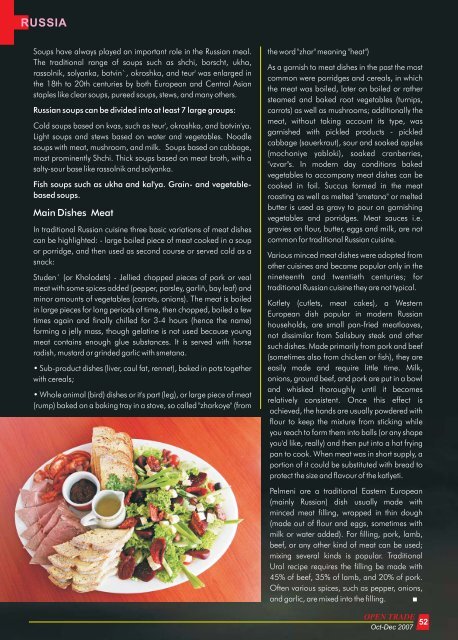pele SciaSction - new media
pele SciaSction - new media
pele SciaSction - new media
Create successful ePaper yourself
Turn your PDF publications into a flip-book with our unique Google optimized e-Paper software.
RUSSIA<br />
Soups have always played an important role in the Russian meal.<br />
The traditional range of soups such as shchi, borscht, ukha,<br />
rassolnik, solyanka, botvin`, okroshka, and teur' was enlarged in<br />
the 18th to 20th centuries by both European and Central Asian<br />
staples like clear soups, pureed soups, stews, and many others.<br />
Russian soups can be divided into at least 7 large groups:<br />
Cold soups based on kvas, such as teur', okroshka, and botvin'ya.<br />
Light soups and stews based on water and vegetables. Noodle<br />
soups with meat, mushroom, and milk. Soups based on cabbage,<br />
most prominently Shchi. Thick soups based on meat broth, with a<br />
salty-sour base like rassolnik and solyanka.<br />
Fish soups such as ukha and kal'ya. Grain- and vegetablebased<br />
soups.<br />
Main Dishes Meat<br />
In traditional Russian cuisine three basic variations of meat dishes<br />
can be highlighted: - large boiled piece of meat cooked in a soup<br />
or porridge, and then used as second course or served cold as a<br />
snack:<br />
Studen´ (or Kholodets) - Jellied chopped pieces of pork or veal<br />
meat with some spices added (pepper, parsley, garliñ, bay leaf) and<br />
minor amounts of vegetables (carrots, onions). The meat is boiled<br />
in large pieces for long periods of time, then chopped, boiled a few<br />
times again and finally chilled for 3-4 hours (hence the name)<br />
forming a jelly mass, though gelatine is not used because young<br />
meat contains enough glue substances. It is served with horse<br />
radish, mustard or grinded garlic with smetana.<br />
• Sub-product dishes (liver, caul fat, rennet), baked in pots together<br />
with cereals;<br />
• Whole animal (bird) dishes or it's part (leg), or large piece of meat<br />
(rump) baked on a baking tray in a stove, so called "zharkoye" (from<br />
the word "zhar" meaning "heat")<br />
As a garnish to meat dishes in the past the most<br />
common were porridges and cereals, in which<br />
the meat was boiled, later on boiled or rather<br />
steamed and baked root vegetables (turnips,<br />
carrots) as well as mushrooms; additionally the<br />
meat, without taking account its type, was<br />
garnished with pickled products - pickled<br />
cabbage (sauerkraut), sour and soaked apples<br />
(mochoniye yabloki), soaked cranberries,<br />
"vzvar"s. In modern day conditions baked<br />
vegetables to accompany meat dishes can be<br />
cooked in foil. Succus formed in the meat<br />
roasting as well as melted "smetana" or melted<br />
butter is used as gravy to pour on garnishing<br />
vegetables and porridges. Meat sauces i.e.<br />
gravies on flour, butter, eggs and milk, are not<br />
common for traditional Russian cuisine.<br />
Various minced meat dishes were adopted from<br />
other cuisines and became popular only in the<br />
nineteenth and twentieth centuries; for<br />
traditional Russian cuisine they are not typical.<br />
Kotlety (cutlets, meat cakes), a Western<br />
European dish popular in modern Russian<br />
households, are small pan-fried meatloaves,<br />
not dissimilar from Salisbury steak and other<br />
such dishes. Made primarily from pork and beef<br />
(sometimes also from chicken or fish), they are<br />
easily made and require little time. Milk,<br />
onions, ground beef, and pork are put in a bowl<br />
and whisked thoroughly until it becomes<br />
relatively consistent. Once this effect is<br />
achieved, the hands are usually powdered with<br />
flour to keep the mixture from sticking while<br />
you reach to form them into balls (or any shape<br />
you'd like, really) and then put into a hot frying<br />
pan to cook. When meat was in short supply, a<br />
portion of it could be substituted with bread to<br />
protect the size and flavour of the katlyeti.<br />
Pelmeni are a traditional Eastern European<br />
(mainly Russian) dish usually made with<br />
minced meat filling, wrapped in thin dough<br />
(made out of flour and eggs, sometimes with<br />
milk or water added). For filling, pork, lamb,<br />
beef, or any other kind of meat can be used;<br />
mixing several kinds is popular. Traditional<br />
Ural recipe requires the filling be made with<br />
45% of beef, 35% of lamb, and 20% of pork.<br />
Often various spices, such as pepper, onions,<br />
and garlic, are mixed into the filling. <br />
OPEN TRADE 52<br />
Oct-Dec 2007

















